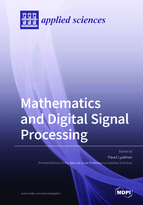Mathematics and Digital Signal Processing
A special issue of Applied Sciences (ISSN 2076-3417). This special issue belongs to the section "Optics and Lasers".
Deadline for manuscript submissions: closed (30 September 2020) | Viewed by 29324
Special Issue Editor
Interests: high performance computing; residue number system arithmetic; digital signal processing; digital image processing; machine learning; artificial intelligence; medical imaging; custom hardware development
Special Issues, Collections and Topics in MDPI journals
Special Issue Information
Dear Colleagues,
Modern computer technology has opened up new opportunities for the development of digital signal processing methods. The applications of digital signal processing have expanded significantly and today include audio and speech processing, sonar, radar, and other sensor array processing, spectral density estimation, statistical signal processing, digital image processing, signal processing for telecommunications, control systems, biomedical engineering, and seismology, among others.
This Special Issue is aimed at wide coverage of the problems of digital signal processing, from mathematical modeling to the implementation of problem-oriented systems. The basis of digital signal processing is digital filtering. Wavelet analysis implements multiscale signal processing and is used to solve applied problems of de-noising and compression. Processing of visual information, including image and video processing and pattern recognition, is actively used in robotic systems and industrial processes control today. Improving digital signal processing circuits and developing new signal processing systems can improve the technical characteristics of many digital devices. The development of new methods of artificial intelligence, including artificial neural networks and brain–computer interfaces, opens up new prospects for the creation of smart technology.
The latest technological developments will be shared through this Special Issue. We invite researchers and investigators to contribute their original research or review articles to this special issue.
Prof. Dr. Pavel Lyakhov
Guest Editor
Manuscript Submission Information
Manuscripts should be submitted online at www.mdpi.com by registering and logging in to this website. Once you are registered, click here to go to the submission form. Manuscripts can be submitted until the deadline. All submissions that pass pre-check are peer-reviewed. Accepted papers will be published continuously in the journal (as soon as accepted) and will be listed together on the special issue website. Research articles, review articles as well as short communications are invited. For planned papers, a title and short abstract (about 100 words) can be sent to the Editorial Office for announcement on this website.
Submitted manuscripts should not have been published previously, nor be under consideration for publication elsewhere (except conference proceedings papers). All manuscripts are thoroughly refereed through a single-blind peer-review process. A guide for authors and other relevant information for submission of manuscripts is available on the Instructions for Authors page. Applied Sciences is an international peer-reviewed open access semimonthly journal published by MDPI.
Please visit the Instructions for Authors page before submitting a manuscript. The Article Processing Charge (APC) for publication in this open access journal is 2400 CHF (Swiss Francs). Submitted papers should be well formatted and use good English. Authors may use MDPI's English editing service prior to publication or during author revisions.
Keywords
- Mathematical models of digital signal processing
- Digital filtering
- Wavelet analysis
- Image and video processing
- Pattern recognition
- Circuits for digital signal processing
- Signal processing systems
- Artificial neural networks
- Biomedical signal processing
- Brain–computer interfaces






